Winter skills in the Cairngorms - Part One.
Having an epic time in January 2023 on a winter skills course with Alice Kerr in the Cairngorms National Park, Scottish Highlands (day one).
Listen here, if you like. ⇾⇾⇾
In January 2023, I took a trip up to the Cairngorms National Park via the Caledonian Sleeper, for four days of exploration: two days low level walking and loch swimming, culminating in a two day epic winter skills course.
This post is all about the course taken with Alice Kerr. Read about the two days spent exploring the lochs and trails of Aviemore before or after.
This is part one: Day One. Subscribe to receive part two directly in your inbox.
Why winter skills?
The reason for this trip stemmed from applying to be one of the selected twenty people on a Fjällräven expedition up in the Arctic. I wasn’t selected — in what seemed to be a rigged process — but I had my heart set on spending some time in the snow. Being that I do take myself off alone up into mountains (albeit UK ones) I figured it would be useful to extend my abilities by participating in a winter skills course.
During my research for social posts for the Fjällräven challenges [which, by the way, you can read about in these three posts: challenge 1 motivations, challenge 2 preparations, challenge 3 sustainability] I came across mountain leader Alice Kerr. She was specifically leading women’s groups, and being female herself, figured I’d feel more comfortable. Not that I’ve had particularly bad experiences being guided by men, but I wanted to support women in these roles.
After we’d had a load of snow dumped in early December — the most I’ve experienced since a trip to the Lake District around 9 years prior — I was really set on having another magical experience, and a bit more involved than walking 3 miles home from Shoreditch at 11.30pm because the buses couldn’t deal with the sudden onslaught. Alice’s Instagram feed showed her rock climbing with control during blizzards into gullies and this confirmed for me that she was the one to learn from.

Cost.
I tend to spend £150 maximum on any trips of a few days away — generally £50 trains, £50 hostel if I’m not camping and then food. This was £110 alone for the Caledonian Sleeper train, but the hostel had a 3-nights-for-2 winter offer on making it £42, and a no-brainer to extend the trip, and this made it feel like a whole load more value. The course itself was £165.
I’m sat here in a local London coffee shop with the rain pouring outside, having spent a week watching people’s snowy adventures continue. I’d visited the Lake District in February in anticipation of exploring the snowy fells alone, but there was no snow. Now it’s back and I’ve got FOMO that I didn’t book Alice’s winter running course in Glen Coe for next week, still sat here now wondering if I can make it work — but it’s another £300 just for a couple days of (extraordinary) fun. After taking 6 trips away in just 10 weeks (one of which was to care for a broken-ankled mum), I do need to just stop for a little while.
Equipment.
However, on top of the trip cost, I also had to purchase mountaineering boots, a mountaineering waterproof, additional base layers and accessories, and snow goggles. All of which will now not be used until winter again. So it does really feel a waste, especially when for 5 days of the week I’m a freelancer. But that’s also part of the issue — London freelancers don’t usually have £300 to spare.
[On the topic of buying goods for an individual trip, here’s what I spent: the boots I found preloved but barely worn on ebay for £60, the jacket was new from Alpkit for £209.99 though they’re a great social business with PFC-free coatings, and I see this jacket as one for life, merino balaclava off ebay £20, merino leggings off Facebook marketplace £25, new merino gloves from Cotswold Outdoors £21.50, and snow goggles from Facebook marketplace with a lovely Alexandra Palace run thrown in for fun to get them]. Crampons, ice axe and helmet were included in the course cost — which for the running course wouldn’t be the case, requiring a £15 hire for the running specific ice axe. I additionally purchased a pair of micro crampons that fit onto trail shoes - for £67.50 - expecting I might have to deal with some snowy trails before the course; this didn’t happen, but they did come out for a peaty bog situation.
Day one.
Clothing and food.
Having spent two days at low level getting a feel for the weather, the trails, the town and the mountains looming around, I was reeling in anticipation — and a little intimidation — at what I was about to face. My bag was packed the night before with all the additional layers and safety stuff we were required to bring — spare base layer, spare warm jacket, emergency bivvi bag, compass, map, whistle, headtorch. Plus I had additional socks as I didn’t know what my boots would be like, spare waterproofs as I was unsure whether the thicker pair (heavier yet less easy to move in) or thinner pair (easier to move in but maybe not strong enough against ice) would be most suitable, and the multitude of layers I was planning on wearing anyway.
Food included a sandwich (unfortunately pre-made from Tesco as this was easier), various snacks of cookies, Lucho’s fruit energy blocks, nuts. And I was bringing my water bladder rather than a bottle as it could fit 2l rather than 750ml, plus a flask of hot coffee. As I was leaving the hostel in excitement to head to the Tiso Outdoor Shop up the road, I noticed a new egg and cress Tesco sandwich on the pavement, seemingly dropped by another winter skills course attendee heading to my hostel - full of guides, skiiers, and winter skills course attendees - for their morning meet. Win.
Morning meet.
Tiso Outdoor Shop was full of tables of guides and their weekend course participants. Alice arrived with dog and mountaineering equipment in tow. Our group of six, including Alice (7 including dog), sat down to learn what we’d be doing during the day, and have a check-in about why we were even there and what we hoped to achieve. My response was that I simply wanted to be in the snow, but practically I wanted to feel more comfortable navigating around in such weather. The rest of the group had some or had minimal winter experience, so we were a mixed bag, and that put me at ease a little. As a year-round gardener and as someone who runs long distance races, I know what it’s like to feel uncomfortable and push myself through that, but it’s different when you’re not just responsible for yourself or can’t easily take yourself out of the situation.
Alice showed us on a map where she hoped we would head for the day, and explained how she had made that decision, effectively so we were able to do this ourselves when planning a day out in the winter mountains. She took us through various weather reports, explaining how the BBC refer to the Met Office so we may as well just focus on the latter, along with specific mountain hilltop assessors (Moutain Weather Info Service), and an avalanche awareness site (Scottish Avalanche Info Service). Later that evening when prepping for day two, I was able to look at those sites to consider what the day may look like (and be pretty much correct in my deduction), and similarly when in the Lakes a month later (despite no snow) I was better placed in my knowledge to address what route to do.
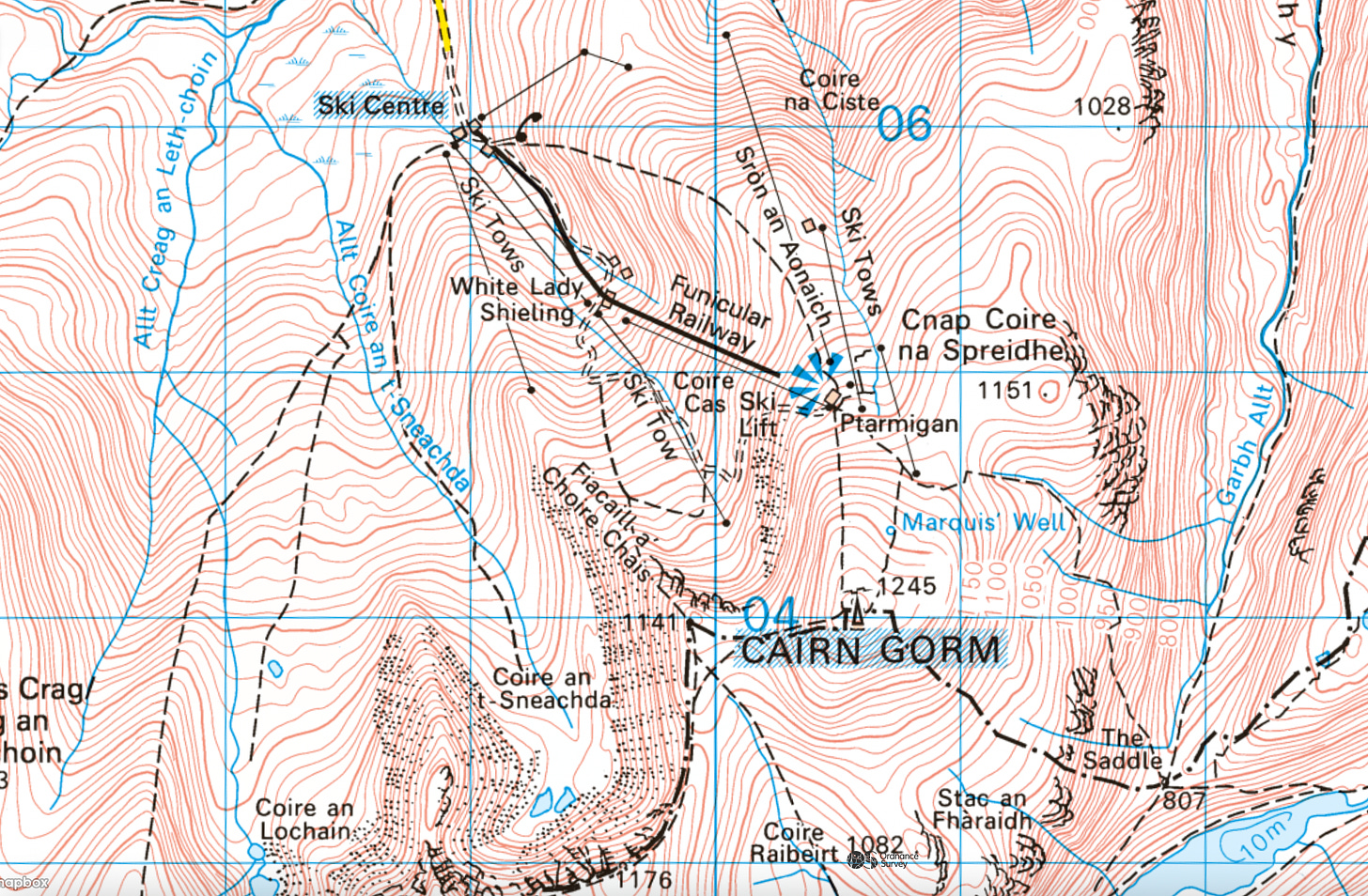
We also discussed the equipment we might need so that Alice could give us the most appropriate kit, or hire from Tiso if necessary. It was for me the first time using an ice axe and crampons, and wearing a mountaineering helmet. I then had to pack these things into my bag, which is why a larger 35-40l rucksack is required, even if not full in the first instance. We then divvied up into vehicles and headed off up the road to the Cairngorm Ski Centre, excitement sizzling as the verges and hills around became more snowy.
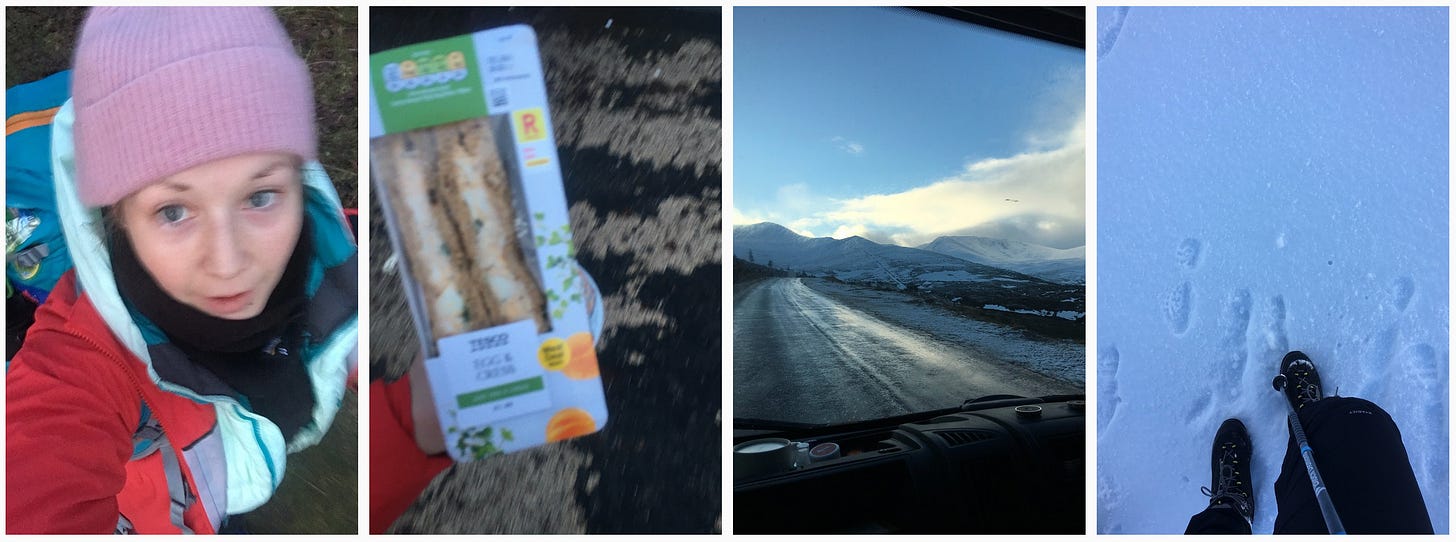
Setting off.
Getting out of the van and settling into the required layers for the temperature drop, with the feeling of the boots being on snow for the first time, I could sense the anticipation inside myself. That I was uncertain and yet ready. It’s how I feel whenever I set out for anything, whether it’s a 5k run or a marathon; abating the thoughts, telling them that I have prepped as well as I can and that all there is to do now is just do the thing. I’m the type who will manage risk rather than spontaneously head out; I don’t have an apocalypse bag but I do photographically/memorially know where certain equipment is, and so all decisions I make are within this remit of “what if?” I’m intrigued as to how I would react should zombies — or war — hit us.
I was uneasy in the car park when moving towards our meet spot by the ski café, as the ground was icy. The morning’s drinks meant I needed to wee, and time doing that always eases some concerns - one less thing to think about. With some more faffing as to what equipment we may need to begin with, I gave Alice one of my trekking poles after seeing her with only one, though I hadn’t checked that either of them worked, and of course the cheap plastic had siezed and wouldn’t tighten the pole into place. The unease of not having a pole on incredibly compacted icy ground caused my body to tense as we stepped down death stairs and slight slopes down out of the ski resort, and I very quickly slipped. Great start.
Alice generously gave up her pole to me, which helped me along the heavily traversed slippy path out and up the hill, across little divets for brooks now frozen and as far as my eyes were concerned, a massive ravine to cross. Reaching a fresh patch of snow going uphill, Alice asked us to consider if we were too warm, and to take layers off now rather doing lots of faffing, which would be worse as we get higher into the wind — which was forecast for 50mph gusts. I took off just one layer, but was still very warm as we headed onwards; I totally hadn’t anticipated how tiring it would be walking in snow, because I’d never really experienced it before. [I was wearing merino leggings, compressive leggings, lightweight waterproof trousers, two pairs of wool socks, merino base layer, polyester t-shirt, fleece, down jacket, waterproof jacket — and I removed only the merino top, though was thankful for the layers as we hit the windy bit and stopped for lunch].
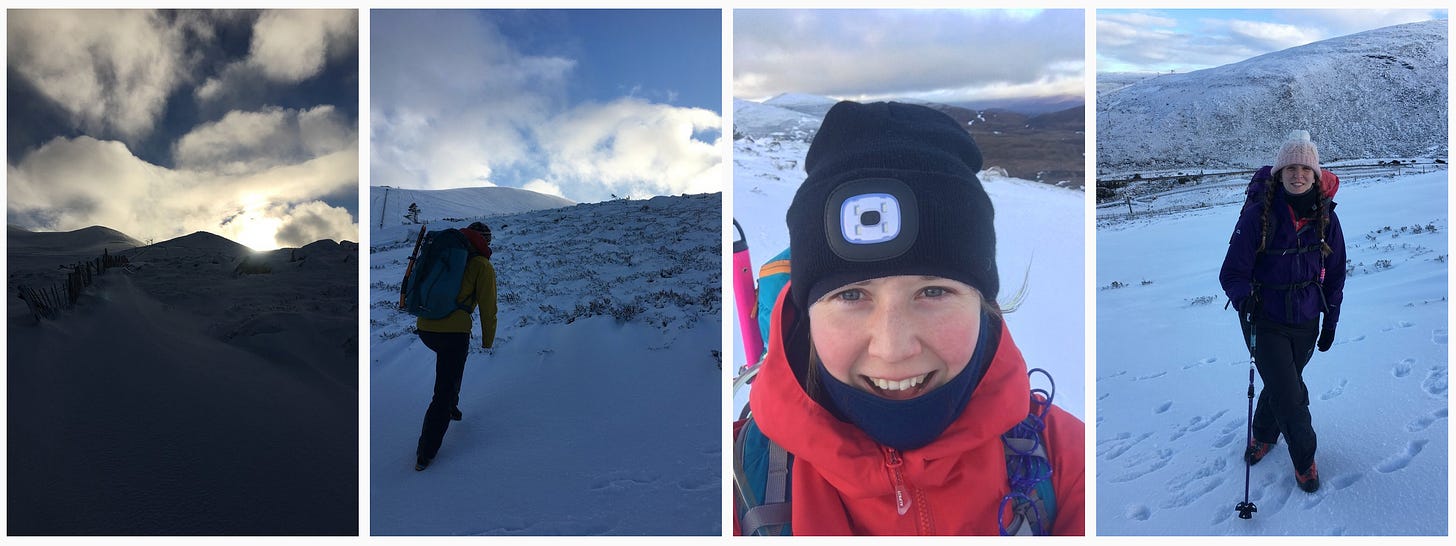
Walking.
On this snowy heathery patch, sheltered from wind and essentially any views, Alice took us through various ways of walking uphill through deep snow, inviting us to reflect on what the ground was doing. As it was heathery, there were areas of soft airyness, surprise rocky boulders, and then simply some snow. We were to navigate ourselves up the short hill — known on the map as White Lady Shieling — and at each new fresh patch, exploring the feeling and effectiveness of walking normally, walking sideways but vertical up, walking sideways but diagonally up, and walking by digging your toes in. This was to set the notion of intention, so as we traversed onwards we were able to read the ground and anticipate what technique we should employ. After the tricky ice path, I felt much more stable, and even quite giddy from walking across a hill without a trail.
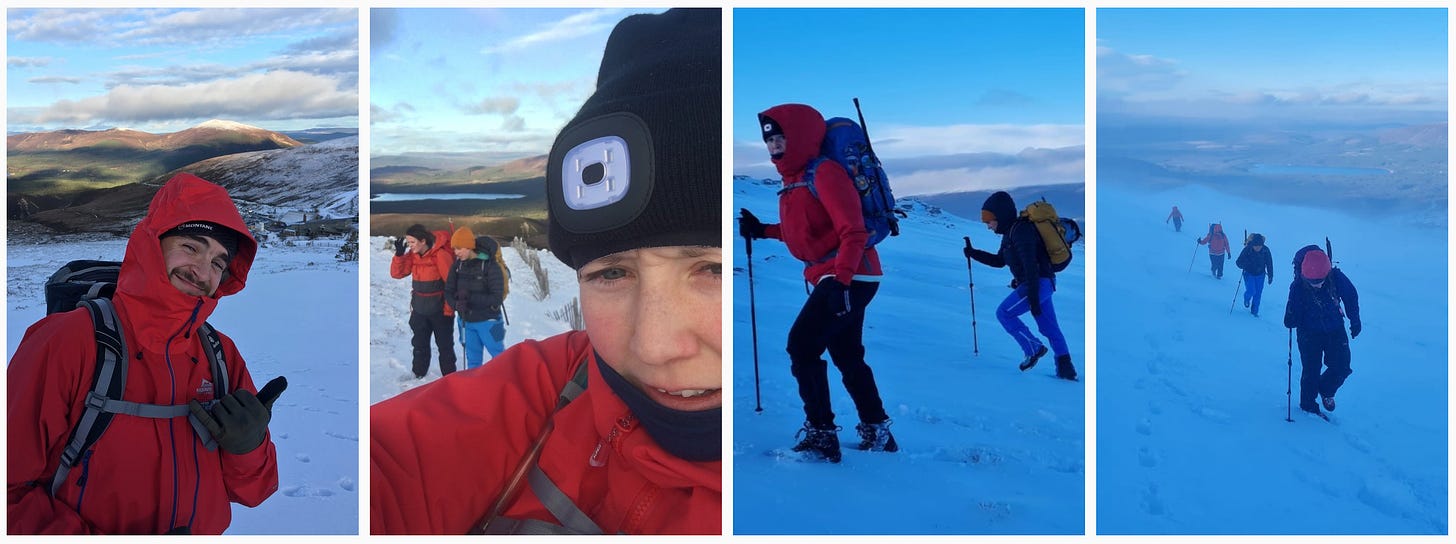
As we rounded the hill, that’s when the ski area with furnicular railway appeared to the left and a big expanse of hill appeared in front, and the wind picked up. Moving onwards we were encouraged into a discussion about the direction of the rime ice on a boulder, to evaluate what it tells us about the wind now, and how it may look tomorrow should the wind or the snow conditions change. Wind direction has always confused me, but with this example I was better able to envision what was going on. Chats continued as we stepped heavily into the deep snow, starting to brace ourselves against the wind gusts that were now making themselves known in the form of spindrifts, gathering off the hill and into the valley. We had stopped to regroup and I took that opportunity to get my phone out for a photo and video, which is when I dropped my glove. In slow motion I watched it blow away as both Alice and B darted across and down respectively to retrieve it. The karma for taking a photo.
We found a spot for lunch by an out-of-use ski tow and looked out across the valley where skiiers were slaloming down or slowly being taken up by another tow. My hot coffee was lukewarm, and I was already noticing that my water bladder tube was freezing so I kept having to blow into it to release the ice. Though it was nice to eat (egg & cress sandwich and a protein bar), it was cold on the bum; others in the group got out a dry bag to sit on, but I sat on my bag, aware of the helmet up at the top. We quickly got cold — I think it was around -15˚C remembering the forecast, but perhaps -25˚C with wind chill. This is why I was pleased about my layered legs, though my torso was doing alright with one less layer. I did decide to put on my merino gloves as well as the waterproof ones (and had a spare waterproof pair in my bag, fortunately for any future mishaps).
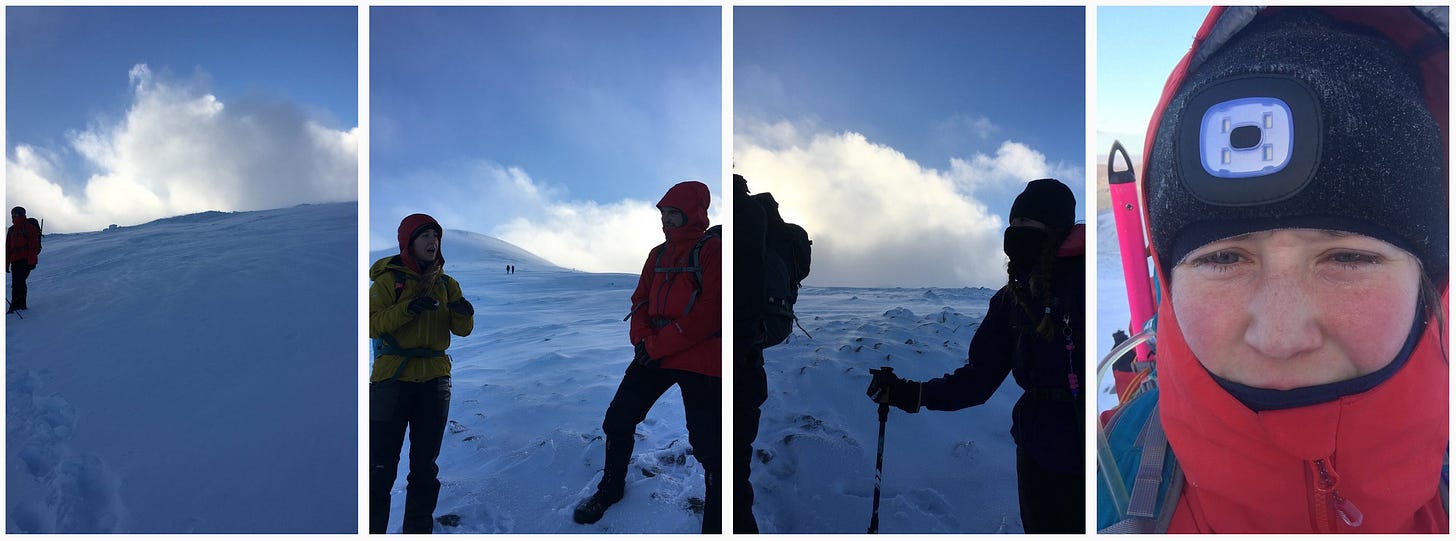
Self-arresting.
Moving onwards again, Alice wanted us to feel what it was like being utterly uncomfortable, and how efficient we needed to be with our movements, when going uphill and bracing the wind gusts, which by now we were facing head-on. As we walked up and crested the ridge — Fiacaill a’ Choire Chais — it was impossible to look ahead due to ice splinters in the eyeballs, but in periodically needing to assess your own direction and that of the group, you had no choice. It was actually all quite invigorating. By this point we could see other groups around the valley, along with some heading further up to the Cairn Gorm plateau proper at 1141m, with Cairn Gorm summit itself at 1245m around to the left and ahead though out of view due to cloud cover. The lack of anything but snow and spindrifts when facing this way gave an air of Everest, to me. A group of six or so were heading in a line up to the plateau, feeling so close yet so far. They turned around and headed back down.
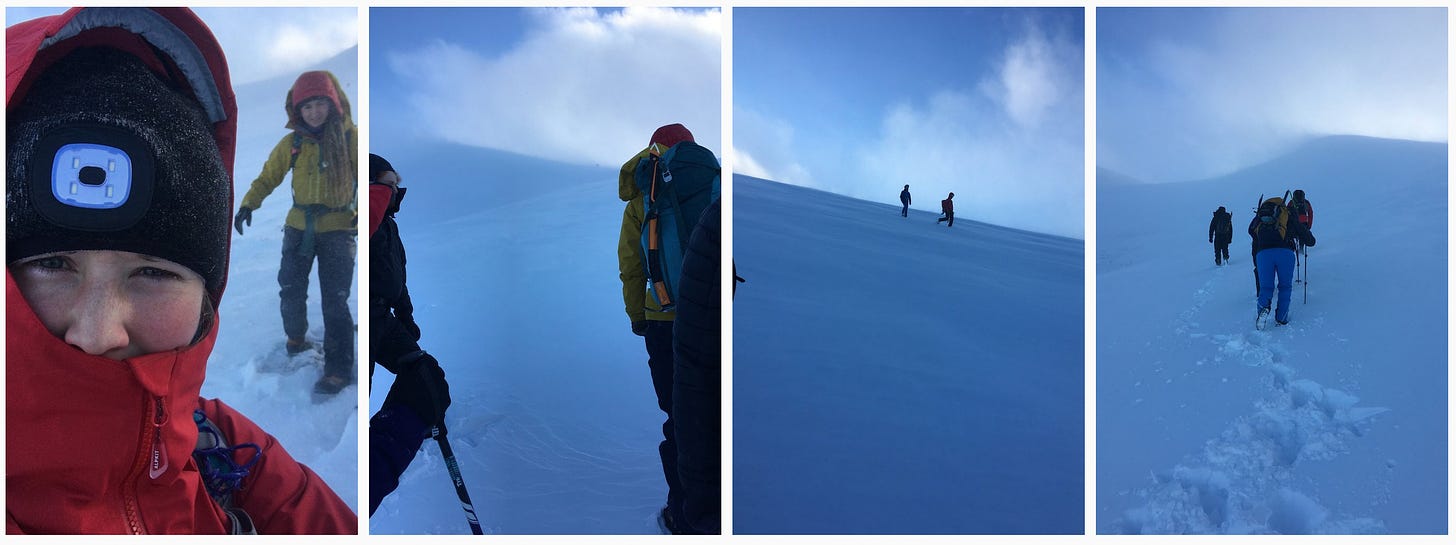
We were now sheltered just a touch down in the valley, where Alice showed us how to dig a trench with our boots and with the adze of our axe so that we could stand upright, place our bag down (with axe handle through the strap) and sit down if required. I have to mention that at this point I was absolutely in discomfort, not from any cold, but from needing a wee, and I was constantly assessing the situation to see where I could go. The trenches I thought were great so I could squat down, but another couple of groups came into this area as Alice was showing us the next bits and that fudged my plan. I guess it’s more realistic that I may need to ice axe arrest when needing to urinate, especially considering I need to wee most hours.
Though the snow was pretty soft, Alice still wanted us to have a play with the technique of arresting — known as self belaying, or the self belay grip. It allowed us to have more of an experiment with the uphill and sideways walking too, because the gradient was steeper. We also recognised how to safely move with an axe too — with preferred hand or ideally uphill hand over the axe head and index/middle fingers down the length, and pick facing backwards — and then pretending to fall to catch ourselves. It really was slightly pointless though as we couldn’t dig the axe in, but I was grateful to have had chance to explore the movements in a fairly passive area. Finally we were going to head off again, and the other groups had dissipated, so my group kindly made a body wall for me so I could wee in my trench, I guess for wind shelter and for people shelter. Unbeknownst to them I did take the minute to get my phone out to video the fascinating and pleasing wee crevasse I’d made.

Sliding.
It had already been an exhilarating day, though come the afternoon, around 2pm, we were told we would start to head down. Alice briefed us through the session on what we were doing and why, bringing us into her decision making, for instance that while it would be epic to head up to Cairn Gorm, we wouldn’t be able to explore many skills and that’s slightly a waste of her expertise and our time with her. So upon leaving the hills, she explained the distance and how long it would usually take to get back. I hadn’t been making a note of the time, so frankly don’t know how much slower I had been walking through the snow than on dry land, and this would be something I’d have to take into consideration when planning trips of my own. They say it’s an additional hour of time for every vertical kilometre, so there must be a similar calculation for moving through snow.
For the premise of this session anyway, it felt like we had covered a lot, spent a lot of time out, and now we could sort of relax a bit. At least for me, my body was more comfortable with the surroundings and I didn’t overthink each step — plus not having a full bladder means you can concentrate on other things. This is when we got to slide! I’ve honestly always been too concerned with sliding down slopes that I’m unsure I’ve ever even sledded before; it’s certainly nothing I ventured forth with when we did have snow and the boys (my group of friends) would freeze icecream tubs of water to go “ice blocking” down the local golf course. However, this situation felt controllable, particularly because the snow was grippy rather than icy; we could slide, but not too far. It was also discovered that D’s waterproof trousers had a slippier finish than the rest of our’s and so she got some speed on — I guess how fast you want to slide may be something you take into consideration when purchasing clothing!
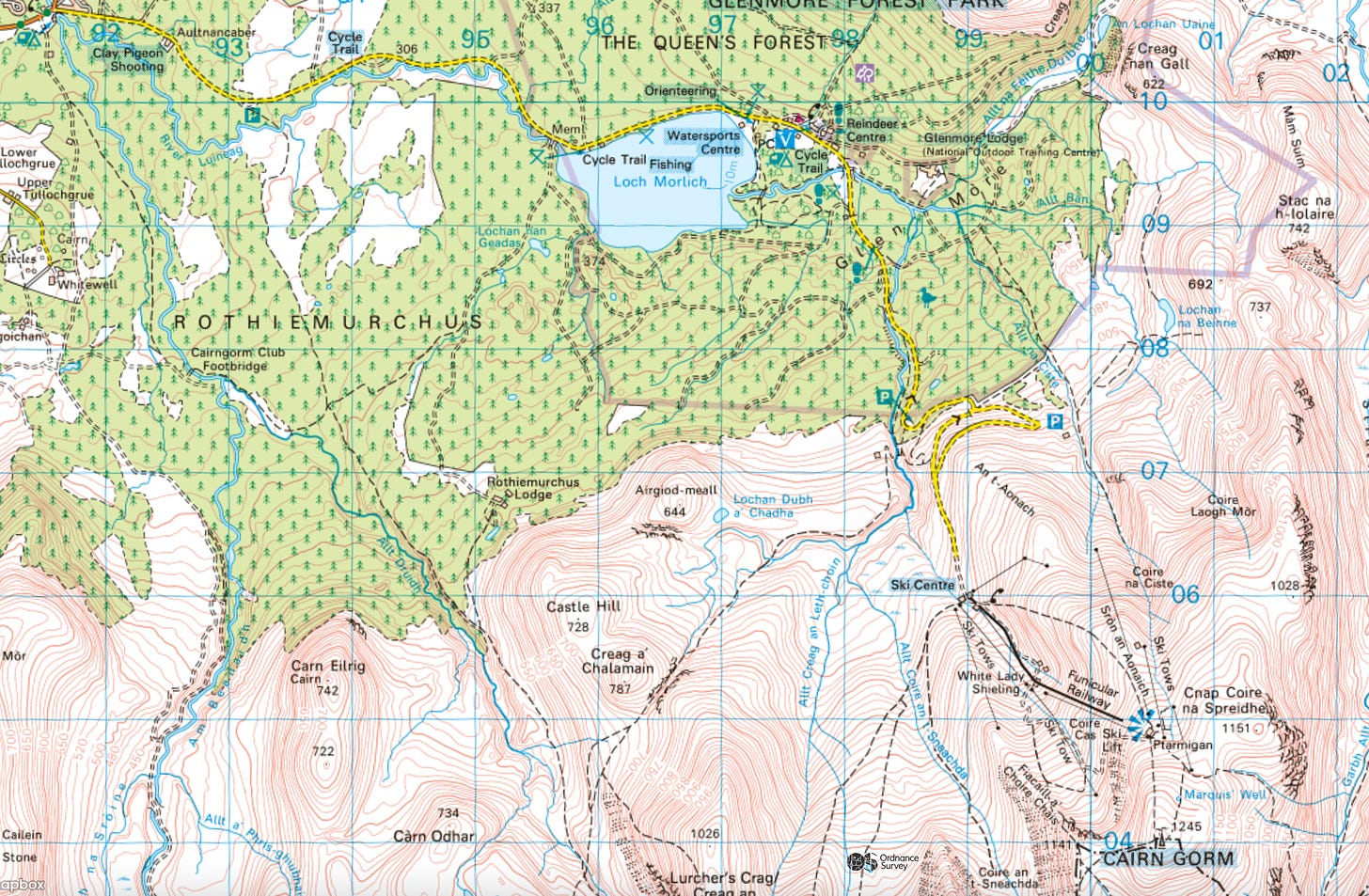
The walk out.
It did feel like it took a while to walk back out and down to the ski centre; it may have been an hour and a half. We essentially walked across to where we’d had lunch and followed the “path” (hidden by snow) back down the White Lady Shieling, with views of Loch Morlich and the Rothiemurchus forest and clouds that had stayed dark blue-grey for the entire day. We avoided walking on the actual ski run in case it was able to be opened the following day, and stuck to the fence where the ski tow was. The snow was deep and on many occasions we were up to our knees, which caused real childish laughter. Some snow angels and snowballs were made too.
I knew what was coming though: the ice. Somehow I managed to get through it — maybe the confidence of the day’s skills had loosened me up — though I was still cautious. Back at the van, I quickly changed out of my boots and hungrily ate — including the cheese and onion Tesco sandwich that was leftover — while Alice drove me down to the hostel. It was quiet and I was able to shower, hang stuff in the drying room, and head back out to Tesco for a top up of snacks for day two along with plenty of reduced items for dinner. Spinach ricotta cannelloni, green veg, garlic bread and clotted cream rice pudding for dessert. No shame, all the happiness.

Liked this story? Please share!
I’ll be back with part two: Day Two, so subscribe to have it sent directly to your inbox.



